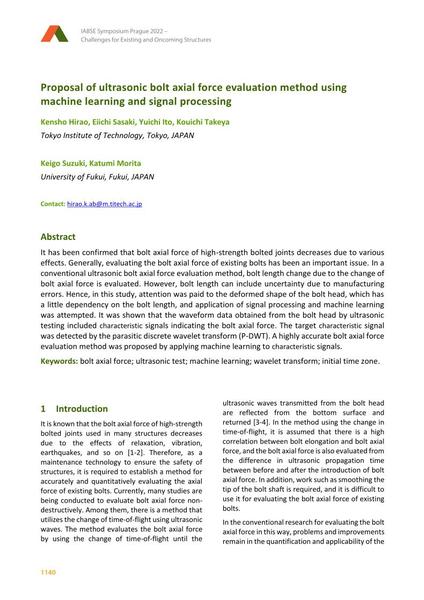Proposal of ultrasonic bolt axial force evaluation method using machine learning and signal processing

|
|
|||||||||||
Bibliografische Angaben
| Autor(en): |
Kensho Hirao
(Tokyo Institute of Technology, Tokyo, JAPAN)
Eiichi Sasaki (Tokyo Institute of Technology, Tokyo, JAPAN) Yuichi Ito (Tokyo Institute of Technology, Tokyo, JAPAN) Kouichi Takeya (Tokyo Institute of Technology, Tokyo, JAPAN) Keigo Suzuki (University of Fukui, Fukui, JAPAN) Katumi Morita (University of Fukui, Fukui, JAPAN) |
||||
|---|---|---|---|---|---|
| Medium: | Tagungsbeitrag | ||||
| Sprache(n): | Englisch | ||||
| Tagung: | IABSE Symposium: Challenges for Existing and Oncoming Structures, Prague, Czech Republic, 25-27 May 2022 | ||||
| Veröffentlicht in: | IABSE Symposium Prague 2022 | ||||
|
|||||
| Seite(n): | 1140-1147 | ||||
| Anzahl der Seiten (im PDF): | 8 | ||||
| DOI: | 10.2749/prague.2022.1140 | ||||
| Abstrakt: |
It has been confirmed that bolt axial force of high-strength bolted joints decreases due to various effects. Generally, evaluating the bolt axial force of existing bolts has been an important issue. In a conventional ultrasonic bolt axial force evaluation method, bolt length change due to the change of bolt axial force is evaluated. However, bolt length can include uncertainty due to manufacturing errors. Hence, in this study, attention was paid to the deformed shape of the bolt head, which has a little dependency on the bolt length, and application of signal processing and machine learning was attempted. It was shown that the waveform data obtained from the bolt head by ultrasonic testing included characteristic signals indicating the bolt axial force. The target characteristic signal was detected by the parasitic discrete wavelet transform (P-DWT). A highly accurate bolt axial force evaluation method was proposed by applying machine learning to characteristic signals. |
||||
| Copyright: | © 2022 International Association for Bridge and Structural Engineering (IABSE) | ||||
| Lizenz: | Die Urheberrechte (Copyright) für dieses Werk sind rechtlich geschützt. Es darf nicht ohne die Zustimmung des Autors/der Autorin oder Rechteinhabers/-in weiter benutzt werden. |
||||
